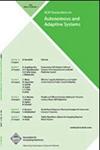机器人群体属性驱动设计:一种基于规定性建模和模型检验的设计方法
IF 2.1
4区 计算机科学
Q3 COMPUTER SCIENCE, ARTIFICIAL INTELLIGENCE
引用次数: 64
摘要
本文提出了一种基于规定性建模和模型检验的自顶向下机器人群体设计方法——属性驱动设计。传统上,机器人群是使用代码和修复方法开发的:在自下而上的迭代过程中,开发人员测试和改进机器人的个体行为,直到获得所需的集体行为。编码和修复方法是非结构化的,所获得的群集的质量完全取决于开发人员的专业知识和独创性,而开发人员在其活动中几乎没有科学或技术支持。属性驱动设计旨在提供这种科学和技术支持,与传统的非结构化方法相比具有许多优势。属性驱动设计由四个阶段组成:首先,开发者通过陈述其期望的属性来正式指定机器人群的需求;其次,开发人员创建群体的规定性模型,并使用模型检查来验证该规定性模型是否满足期望的属性;第三,以规定性模型为蓝图,开发人员实现了期望机器人群的仿真版本,并验证了上一步开发的规定性模型;第四,开发人员实现所需的机器人群并验证前面的步骤。我们使用两个案例研究来演示属性驱动设计:聚合和觅食。本文章由计算机程序翻译,如有差异,请以英文原文为准。
Property-Driven Design for Robot Swarms: A Design Method Based on Prescriptive Modeling and Model Checking
In this article, we present property-driven design, a novel top-down design method for robot swarms based on prescriptive modeling and model checking. Traditionally, robot swarms have been developed using a code-and-fix approach: in a bottom-up iterative process, the developer tests and improves the individual behaviors of the robots until the desired collective behavior is obtained. The code-and-fix approach is unstructured, and the quality of the obtained swarm depends completely on the expertise and ingenuity of the developer who has little scientific or technical support in his activity. Property-driven design aims at providing such scientific and technical support, with many advantages compared to the traditional unstructured approach. Property-driven design is composed of four phases: first, the developer formally specifies the requirements of the robot swarm by stating its desired properties; second, the developer creates a prescriptive model of the swarm and uses model checking to verify that this prescriptive model satisfies the desired properties; third, using the prescriptive model as a blueprint, the developer implements a simulated version of the desired robot swarm and validates the prescriptive model developed in the previous step; fourth, the developer implements the desired robot swarm and validates the previous steps. We demonstrate property-driven design using two case studies: aggregation and foraging.
求助全文
通过发布文献求助,成功后即可免费获取论文全文。
去求助
来源期刊

ACM Transactions on Autonomous and Adaptive Systems
工程技术-计算机:理论方法
CiteScore
4.80
自引率
7.40%
发文量
9
审稿时长
>12 weeks
期刊介绍:
TAAS addresses research on autonomous and adaptive systems being undertaken by an increasingly interdisciplinary research community -- and provides a common platform under which this work can be published and disseminated. TAAS encourages contributions aimed at supporting the understanding, development, and control of such systems and of their behaviors.
TAAS addresses research on autonomous and adaptive systems being undertaken by an increasingly interdisciplinary research community - and provides a common platform under which this work can be published and disseminated. TAAS encourages contributions aimed at supporting the understanding, development, and control of such systems and of their behaviors. Contributions are expected to be based on sound and innovative theoretical models, algorithms, engineering and programming techniques, infrastructures and systems, or technological and application experiences.
 求助内容:
求助内容: 应助结果提醒方式:
应助结果提醒方式:


